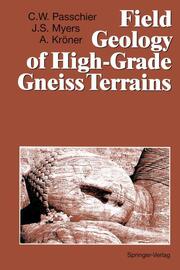Detailansicht
Field Geology of High-Grade Gneiss Terrains
ISBN/EAN: 9783540530534
Umbreit-Nr.: 4151173
Sprache:
Englisch
Umfang: ix, 150 S., 57 s/w Illustr., 150 p. 57 illus.
Format in cm:
Einband:
kartoniertes Buch
Erschienen am 30.11.1990
Auflage: 1/1990
- Zusatztext
- Although there are numerous publications on the geology of high-grade gneiss terrains, few descriptions exist of how to map and carry out structural analysis in these terrains. Textbooks on structural geology concentrate on technIques appli cable to low-grade terrains. Geologists who have no experience of mapping high-grade gneisses are often at a loss as to how to apply techniques to high grade rocks that were developed for low to medium grade metamorphic terrains. Any study of deep crustal processes and their development through time should begin with examination of the primary data source - outcrops of high grade metamorphic terrains. We feel that the urge to apply advanced techniques of fabric analysis, petrology, geochemistry, isotope geochemistry and age deter mination to these rocks often results in brief sampling trips in which there is little, if any analysis of the structural and metamorphic history revealed by outcrop patterns. Many studies of the metamorphic petrology and geochemistry of high-grade gneiss terrains make ineffective use of available field data, often because the authors are unaware of structural complexities and of the ways to recognise and use them. This is unfortunate, because much data can be collected in the field at minimal cost that cannot easily, if at all, be obtained from material in the laboratory. The primary igneous or sedimentary nature of a rock, the relative age of intrusive veins, and the sequence of deformation that they under went, can usually best be determined by straightforward observation in the field.
- Schlagzeile
- Inhaltsangabe1 Introduction.- 2 Mapping in Gneiss Terrains.- 2.1 Introduction.- 2.2 General Problems.- 2.3 Working Method.- 2.4 Outcrop Analysis.- 2.5 What to Map.- 2.6 Types of Maps 7.- 2.7 Scheme of Events.- 2.8 Sampling.- 3 Fabric Development in Gneiss Terrains.- 3.1 Introduction.- 3.2 The Geometry of Ductile Flow in Rocks.- 3.2.1 Coaxial or Non-Coaxial Flow.- 3.2.2 Effects of Progressive Deformation.- 3.3 Fabric Elements.- 3.3.1 Granoblastic Fabrics.- 3.3.2 Shape and Mineral Fabrics.- 3.3.3 Layering.- 3.3.4 Augen Structures in Gneiss.- 3.4 Shear Zones in High-Grade Conditions.- 3.4.1 Introduction.- 3.4.2 Development of Fabrics in Shear Zones.- 3.4.3 Isoclinal Folds in Shear Zones.- 3.5 Fabric Distribution in Shear Zones.- 3.5.1 Introduction.- 3.5.2 The Semi-Brittle Deformation Regime.- 3.5.3 Cataclasite and Pseudotachylyte.- 3.5.4 The Transition Zone.- 3.5.5 Relation of Brittle and Ductile Fault Rocks in Gneiss Terrains.- 4 Interpretation of Structures and Fabrics.- 4.1 The Inadequate Memory of Rocks.- 4.2 Igneous or Sedimentary Origin of Gneisses.- 4.2.1 General Guidelines.- 4.2.2 Apparent Sedimentary Structures.- 4.3 Assessment of Strain Intensity.- 4.4 Shear Zones.- 4.4.1 Recognition of Shear Zones.- 4.4.2 Deformation in Shear Zones.- 4.4.3 Determining Movement Direction Using Lineations.- 4.4.4 Determining Movement Direction in Absence of Lineations.- 4.4.5 Shear Sense Criteria.- 4.5 Folds and Boudins.- 4.6 Overprinting Relations Involving Folds and Boudins.- 4.6.1 Introduction.- 4.6.2 Fold Interference.- 4.6.3 Deformed Vein Sets.- 4.7 Overprinting Relations Involving Intrusions.- 4.7.1 General Guidelines.- 4.7.2 Intersection Geometry of Planar Intrusions.- 4.7.3 Interaction of Dykes and Shear Zones.- 4.7.4 Reactivated Shear Zones.- 4.7.5 Partial Melt Veins.- 4.8 Outcrop Surface and Fabric Patterns.- 4.8.1 General Problems.- 4.8.2 Lineations and Foliation Traces.- 5 Metamorphic History of Gneiss Terrains.- 5.1 Introduction.- 5.2 Metamorphic History.- 5.3 Fabric Evidence for Metamorphic History.- 5.4 Metamorphic Conditions.- 5.4.1 Introduction.- 5.4.2 Mineral Assemblages in High-Grade Metamorphism.- 5.4.3 Mineral Assemblages in High to Medium Grade Retrogression.- 5.4.4 Mineral Assemblages in Low-Grade Retrogression.- 5.5 Sites to Study Retrogression Fabrics.- 5.6 Relative Dating of Metamorphic Events.- 5.7 Isograd Patterns.- 5.8 Geothermobarometry.- 6 Geochemistry, Isotope Geochemistry and Geoehronology: Application to Field Studies.- 6.1 Introduction.- 6.2 Geochemistry.- 6.3 Isotope Geochemistry.- 6.4 Geochronology.- 6.4.1 Introduction.- 6.4.2 Sm-Nd Method of Dating.- 6.4.3 U-Pb Dating of Zircons.- 7 Origin and Evolution of High-Grade Gneiss Terrains.- 7.1 Introduction.- 7.2 Two Kinds of Gneiss Terrain.- 7.3 Crustal Structure of Gneiss Terrains.- 7.4 Origin and Evolution of High-Grade Gneiss Terrains.- 8 Problem Section.- 8.1 Introduction.- 8.2 Informative Misinterpretations.- 8.3 Problems.- 9 References.- 10 Index.
